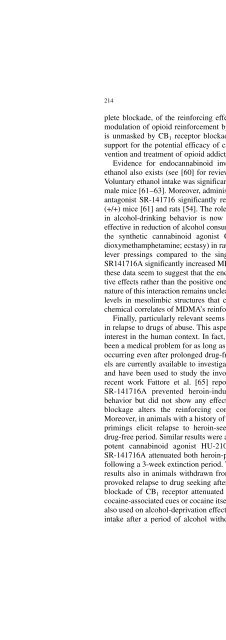3. Umbruch 4.4..2005 - Online Pot
3. Umbruch 4.4..2005 - Online Pot
3. Umbruch 4.4..2005 - Online Pot
You also want an ePaper? Increase the reach of your titles
YUMPU automatically turns print PDFs into web optimized ePapers that Google loves.
214 D. Parolaro and T. Rubino<br />
plete blockade, of the reinforcing effects of heroin, suggesting a facilitatory<br />
modulation of opioid reinforcement by endogenous cannabinoid activity that<br />
is unmasked by CB 1 receptor blockade. All these lines of evidence provide<br />
support for the potential efficacy of cannabinoid CB 1 antagonists in the prevention<br />
and treatment of opioid addiction.<br />
Evidence for endocannabinoid involvement in the rewarding effects of<br />
ethanol also exists (see [60] for review). Here we only cite the latest papers.<br />
Voluntary ethanol intake was significantly lower in CB 1 –/– versus CB1 +/+ young<br />
male mice [61–63]. Moreover, administration of the cannabinoid CB 1 receptor<br />
antagonist SR-141716 significantly reduced ethanol intake in CB 1 wild-type<br />
(+/+) mice [61] and rats [54]. The role of endocannabinoids and CB 1 receptor<br />
in alcohol-drinking behavior is now unequivocal; thus SR-141716 may be<br />
effective in reduction of alcohol consumption. Surprisingly the combination of<br />
the synthetic cannabinoid agonist CP-55,940 with MDMA (methylenedioxymethamphetamine;<br />
ecstasy) in rat reduced the number of drug-associated<br />
lever pressings compared to the single drugs [64] and pre-treatment with<br />
SR141716A significantly increased MDMA self administration. At first glance<br />
these data seem to suggest that the endocannabinoid system might have negative<br />
effects rather than the positive ones shown in the above cited studies. The<br />
nature of this interaction remains unclear due to the lack of studies on dopamine<br />
levels in mesolimbic structures that could add further insight on the neurochemical<br />
correlates of MDMA’s reinforcing properties.<br />
Finally, particularly relevant seems to be the role of endocannabinoid tone<br />
in relapse to drugs of abuse. This aspect of drug addiction assumes a striking<br />
interest in the human context. In fact, detoxification from drug addiction has<br />
been a medical problem for as long as drugs have been abused, due to relapse<br />
occurring even after prolonged drug-free periods. Several reinstatement models<br />
are currently available to investigate major factors contributing to relapse<br />
and have been used to study the involvement of the cannabinoid system. In<br />
recent work Fattore et al. [65] reported that the CB 1 receptor antagonist<br />
SR-141716A prevented heroin-induced reinstatement of heroin-seeking<br />
behavior but did not show any effect per se, suggesting that CB 1 receptor<br />
blockage alters the reinforcing consequences of heroin administration.<br />
Moreover, in animals with a history of heroin self-administration, cannabinoid<br />
primings elicit relapse to heroin-seeking behavior following an extended<br />
drug-free period. Similar results were also obtained by De Vries et al. [66]: the<br />
potent cannabinoid agonist HU-210 reinstated heroin seeking, whereas<br />
SR-141716A attenuated both heroin-primed and cue-induced heroin seeking<br />
following a 3-week extinction period. The same group [67] found very similar<br />
results also in animals withdrawn from cocaine self-administration: HU-210<br />
provoked relapse to drug seeking after a prolonged withdrawal period, while<br />
blockade of CB 1 receptor attenuated the relapse induced by re-exposure to<br />
cocaine-associated cues or cocaine itself. The CB 1 cannabinoid antagonist was<br />
also used on alcohol-deprivation effects (i.e. the temporary increase in alcohol<br />
intake after a period of alcohol withdrawal) in Sardinian alcohol-preferring







